#Pacific Marten
Text
Phylogenetic weasel tournament
Family: Mustelidae
Subfamily: Guloninae
Genus: Martes

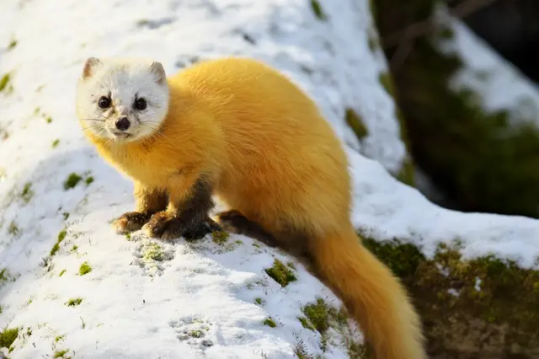
Another incredible mustelid enters the tournament. This family just gives and gives




pictures: 1, 2, 3, 4, 5, 6
#yellooowww#polls#tournament poll#phylogenetic weasel tournament#guloninae#pacific marten#japanese marten#nyugati és feketelábú nyest magyarul#nem hiszem el hogy valaki a fekete lábat látta a legjellegzetesebbnek rajta
69 notes
·
View notes
Text


Pacific marten (Martes caurina)
Warm River, Idaho, United States
Photos [1, 2] © Steve Jones
121 notes
·
View notes
Text

Martez :3 my Pacific Marten sona :)
Artwork and character by me
Character: Martez The Pacific Marten
#my art#art#anthro#furry#furry art#fursona#sfw anthro#sfw furry#marten#pacific marten#mustelid fursona#marten fursona
10 notes
·
View notes
Text
mustelid otd !! ✨
➤ pacific marten 🏔️🪵
although they are almost indistinguishable from each other physically, they are different from american pine martens!

16 notes
·
View notes
Note
"furries for trees" birds
(i kknow this isnt what u meant but it was my first thought Hgjfjd)
slfhksvdmsfg FAIR! i've recently been informed if i was a bird i'd be a sparrow actually? but what i'm looking for here is How To be A Western Red Cedar please please please please please let me be a tree
#guy who gets stoned and goes for a walk and hits on the trees at the park voice. its ok they flirt back#jam replies#friends#the THING IS i have put thought into what my fursona would be (pacific marten) but i feel alienated from being a person in a way where it's#more like.. being human is my fursona. humans are an animal. i'm a fey thing. i should be a tree
3 notes
·
View notes
Text

You can tell I had more of an idea happening with these two (I’m sticking with the mouse over the squirrel for shinji)
#also forgot to note on kaworus dove design his little nose thing over his beak is heart shaped while rei’s is more circular in her pigeon#nge#asuka langley soryu#shinji ikari#anthro au#if you haven’t seen a pacific marten look it up they have a patch of fur thays the perfect asuka color#i knew I wanted a weasel animal for asuka and I’m glad I found the perfect one#i love asuka she’s my favorite#her whole body is very expressive her fur will puff or lay down at the tiniest things#neon gensis evangelion
2 notes
·
View notes
Text
Today's Wet Beast Wednesday is about sea otters. I was originally going to do this last week in honor of the 24th birthday of Rosa, the world's oldest sea otter (and one of the oldest sea otters on record) but, well, I forgot. But better late than never.
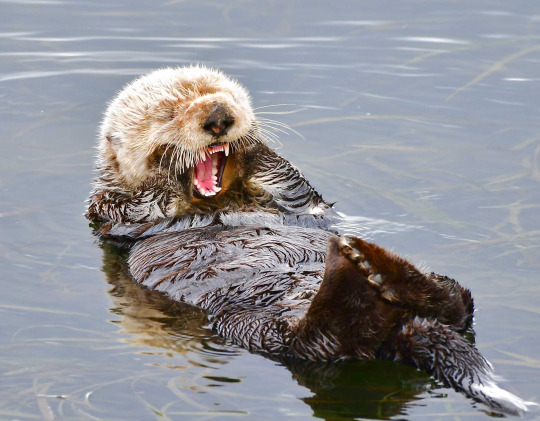
(Image: a sea otter on its back, yawning)
The sea otter (Enhydra lutris) is one of only two otters to live in salt water, the other being the rare and poorly-understood marine otter (Lontra felina). Otters are aquatic mammals of the family Mustelidae, which makes them cousins to weasels, badgers, wolverines, and martens. While many mustelids can swim, otters have adapted to a primarily aquatic lifestyle. Sea otters are divided into three subspecies: the Asian sea otter (Enhydra lutris lutris) which lives from northernmost Japan up through the northwest Pacific, northern sea otter (E. l. kenyoni) which lives from Alaska down to Oregon, and the southern sea otter (E. l. nereis), found in California.
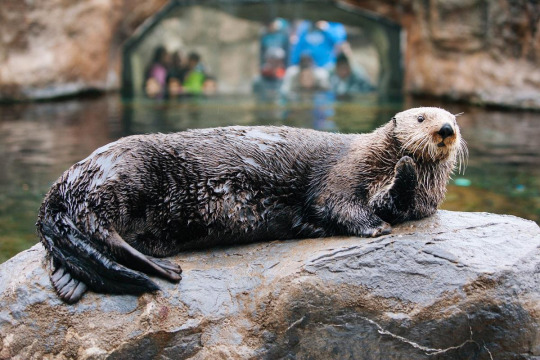
(image: a sea otter relaxing on a rock)
The sea otter is one of the smallest marine mammals (only the marine otter is smaller), yet it is also the heaviest of all mustelids. Males are larger than females, averaging between 1.2 and 1.5 meters (3'11" to 4'11") and 22 to 45 kg (49 to 99 lbs). Females average 1 to 1.4 m (3'3" to 4'7") and 14 to 33 kg (31 to 73 lbs). I honestly thought they were around the size of cats and was surprised to find out how big they can get. Otters are the most recent of the marine mammals and have not developed the thick layer of blubber other marine mammals use to keep themselves warm. Instead, sea otters warm themselves with the densest fur of any mammal, with almost a million hairs per square inch. The fur has two distinct layers: a longer layer of waterproof guard hairs and a shorter underfur layer. The guard hairs keep the underfur dry and trap air between the layers. This air gets heated by the otters body heat and provides an extra layer of insulation. This is the same principle that wet suits work on. The air layer also provides some added buoyancy. Sea otters are positively buoyant and can float on the surface of the water. There are many other adaptations to an aquatic lifestyle that sea otter have. Their feet are webbed and have long digits, allowing them to act as flippers but also making them slower and more clumsy on land. The front claws have retractable claws and pads that let them grab onto slippery objects. When swimming, they use their entire real bodies, but primarily their hind feet, for propulsion. They can hold their breath for up to five minutes and have whiskers used to search for food in darker water. Their ears and nostrils close when submerged to keep water out. While sea otter can, and often do, move around on land, they are capable of living their entire lives in the water. Some evolutionary biologists think sea otters represent an early stage of marine mammal development and can compare them to more established marine mammals like cetaceans and pinnipeds.

(image: a wet weasel holding a sea urchin)
Sea otters are carnivores whose diet consists mostly of hard-shelled invertebrates, though they will also eat fish. They forage for food on the sea floor in dives that usually last a minute. Their paws give them an advantage over other marine mammals, who can only use their mouths for capturing prey. Otters by contrast can pick up and move rocks and dig into the sediment. They are the only marine mammals to catch prey with their paws instead of teeth. Otters carry prey to the surface and eat while floating on their backs. Famously, they use rocks to break open the hard shells of their prey, making them one of the relatively few mammals to use tools (though tool use is proving to be more common than previously thought). Under each arm is a pouch of loose skin that is used to hold prey and rocks. Each otter has a favorite rock that they carry with them. Sea otters have blunt teeth used to crush through prey's shells.

(image: an otter dining on crab)
While sea otters do spend a lot of time in groups, they are not considered truly social animals as they forage, groom, and defend themselves on their own instead of with help. Groups of otters are called rafts that typically have between 10 and 100 members, but can reach up to 2000 members. Rafts are single sex, each having only male or female members. When resting, raft members will hold hands to keep themselves from drifting apart. One social behavior they engage in is play, which is done frequently. Mating season happens in autumn. During summer and autumn, males will attempt to establish territories and push other males out. Females mover between territories at will. Males without territories will swim around and attempt to find females in heat. Males will attempt to mate with multiple females. During estrus, the males and females will bond through play and sometimes aggressive behavior. When mating, the male will bite the female's head, which can leave scars. Otters are capable of delayed embryo implantation, where they can wait for several months between conception and the embryo beginning development. Pregnancy lasts four months and typically results in a single pup. While males are absentee fathers, females are very caring mothers who spend almost all their time caring for their pups. The only time she leaves her pup will be when diving. The pup will be left floating on the surface, often wrapped with kelp to keep it from floating away. The baby will cry for its mother until she comes back. The mother will teach her pup how to dive and forage as it ages. Pups will stay with their mothers for 6 to 8 months (longer in colder areas), and sometimes until they are fully developed. Childless females will foster orphaned pups. Females reach sexual maturity at age 3-4 and males around age 5. They average 10 - 15 years in the wild and can live significantly longer in captivity. The oldest living sea otter is Rosa, living in the Monterey Bay Aquarium, who is 24 years old. The oldest sea otter on record was a female named Etika who lived to be 28.
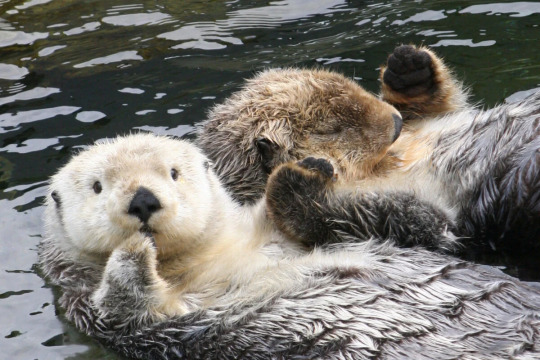
(image: two sea otters holding hands)
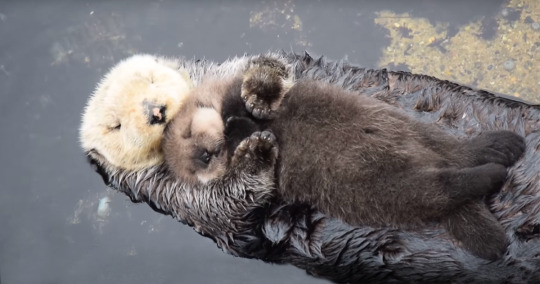
(image: a sea otter mother sleeping with its baby on its stomach)
Sea otters are a classic example of an endangered species. They have been hunted throughout history for their fur. Eventually, this reduced the world population to less than 2000 individuals. They are now the target of conservation measures worldwide and local and international protections, which has helped the population rebound. They still have not regained their historical population or range, though reintroduction measures have helped them reestablish in historical territories. The southern sea otters are the most endangered. Famously, almost all southern sea otters alive today are descended from a group of 50 discovered in 1938, when the subspecies was almost extinct. Sea otters are classified as endangered by the IUCN. Sea otters are a keystone species, having a major ecological impact on their habitats. Famously in California, the near-extinction of southern sea otters resulted in a population boon of sea urchins (their primary prey) which proceeded to kill vast areas of kelp forest. Curren threats include predation, pollution, and habitat loss. Oil spills are particularly devastating to sea otters, as the oil destroys the air layer in their fur, destroying their ability to keep themselves warm.
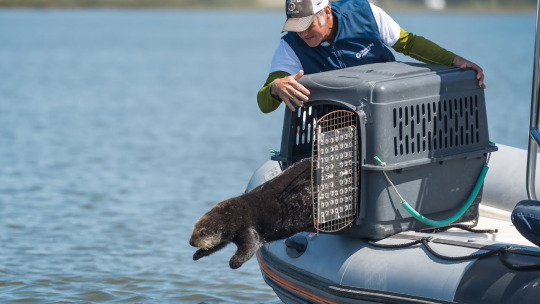
(image: an employee with MBARI releasing a rehabilitated sea otter back into the wild)
#wet beast wednesday#sea otter#otter#marine mammals#wet weasel#water weasel#moist mustelid#marine biology#biology#zoology#ecology#animal facts#adorable
366 notes
·
View notes
Text
I would like to offer this resource for therians, an extensive list of all of Sir David Attenborough’s nature documentaries that are available on soap2day, and a full list of what species* they each (notably, prominently) feature the natural behaviors of, separated by episode, and omitting species that were only shown dead, juvenile or being predated on. This took me a while (I have been working on it since Prehistoric Planet’s release) because I did in fact have to watch every single series in full in order to list all the species and the episodes are around 50 minutes long, but enjoy.
Long post ahead:
Most of these shows have closed captioning, which is why I’ve picked soap2day. Planet Earth is the only one that doesn’t. I did not include Dynasties and Dynasties II because each episode only features one species.
Thank you to Birch (@ambiguousmutt) for his help (he watched about half of the episodes) so I didn’t have to do it individually. Credit goes to him as well.
*Sometimes Attenborough doesn’t say the specific species and I was too busy trying to get through the episodes to identify it. In those cases I just put the most specific name I could.
Planet Earth
Episode one (From Pole to Pole): emperor penguin, polar bear, caribou, arctic grey wolf, Amur leopard, six-plumed bird-of-paradise, superb bird-of-paradise, great white shark, African elephant, African buffalo, lechwe, baboon, African wild dog
Episode two (Mountains): gelada, walia ibex, Ethiopian wolf, guanaco, cougar, grizzly bear, markhor, snow leopard, golden eagle, grey wolf, panda, golden snub-nosed monkey, red panda, demoiselle crane
Episode three (Fresh Water): giant salamander, grizzly bear, smooth-coated otter, Nile crocodile, dolphin fish, midge, Amazon river dolphin, dorado, piranha, spectacled caiman, crab-eating macaque, snow goose
Episode four (Caves): wrinkle-lipped free-tailed bat, cockroach, bat hawk, cave swiftlet, yellow-red rat snake, Texas blind salamander
Episode five (Deserts): Bactrian camel, dromedary camel, red kangaroo, fennec fox, guanaco, long-nosed bat, Nubian ibex, flat lizard, lion, African elephant, locust
Episode six (Ice Worlds): snow petrel, Antarctic petrel, south polar skua, humpback whale, emperor penguin, eider, muskox, arctic grey wolf, polar bear, little auk, arctic fox
Episode seven (Great Plains): Mongolian gazelle, red-billed quelea, wildebeest, snow goose, arctic fox, arctic grey wolf, bison, wild ass, Tibetan fox, pygmy hog, African elephant, lion, baboon
Episode eight (Jungles): magnificent bird-of-paradise, spider monkey, howler monkey, siamang gibbon, gliding tree frog, colugo, red crab spider, African elephant, chimpanzee
Episode nine (The Shallow Seas): humpback whale, multiple corals, banded sea krait, trevally, dugong, bottlenose dolphin, Socotra cormorant, salp, comb jelly, sea lion, dusky dolphin, sea urchin, sunflower starfish, short-tailed stingray, great white shark, king penguin, fur seal
Episode ten (Seasonal Forests): Eurasian lynx, moose, crossbill, wolverine, western capercaillie, pine marten, great grey owl, pudu, kodkod, mandarin duck, cicada, red deer, Amur leopard, tiger, mouse lemur
Episode eleven (Ocean Deep): whale shark, oceanic whitetip shark, common dolphin, Cory's shearwater, manta ray, sea spider, vampire squid, spider crab, unnamed deep sea eel, giant isopod, chambered nautilus, Pacific spotted dolphin, mola mola, frigatebird, sailfish, blue whale
Planet Earth II
Episode one (Islands): pygmy three-toed sloth, Komodo dragon, sifaka, marine iguana, Galapagos racer, Buller's albatross, fairy tern, Christmas Island red crab, yellow crazy ant, chinstrap penguin
Episode two (Mountains): Nubian ibex, red fox, golden eagle, grizzly bear, bobcat, flamingo, mountain viscacha rat, snow leopard
Episode three (Jungles): spider monkey, flying lizard, sword-billed hummingbird, river dolphin, jaguar, glass frog, paper wasp, click beetle, red bird of paradise, Wilson's bird of paradise, indri
Episode four (Deserts): lion, Harris's hawk, shrike, locust, sand grouse, pale chanting goshawk, feral mustang, golden mole, desert long-eared bat, darkling beetle, Namaqua chameleon
Episode five (Grasslands): saiga antelope, lion, harvest mouse, carmine bee-eater, Kori bustard, African elephant, serval, Jackson's widowbird, grasscutter ant, compass termite, giant anteater, bison, red fox, arctic grey wolf
Episode six (Cities): langur, peregrine falcon, leopard, European starling, great bowerbird, raccoon, rhesus macaque, spotted hyena, wels catfish
Our Planet
Episode one (One Planet): lesser flamingo, orchid bee, golden-collared manakin, red-capped manakin, blue manakin, cormorant, booby, common dolphin, shearwater, African wild dog, timber wolf
Episode two (Frozen Worlds): gentoo penguin, wandering albatross, narwhal, Pacific walrus, humpback whale, orca, leopard seal, polar bear
Episode three (Jungles): lowland gorilla, forest elephant, black sicklebill, twelve-wired bird-of-paradise, western parotia, mountain treeshrew, Philippine eagle, black spider monkey, leafcutter ant, Sumatra orangutan, velvet worm
Episode four (Coastal Seas): northern fur seal, compass jellyfish, giant trevally, mobula ray, Atlantic stingray, bottlenose dolphin, grey reef shark, whitetip reef shark, sea otter, California sheephead wrasse, Steller's sea lion, bald eagle, humpback whale, Guanay cormorant, Inca tern, Peruvian booby, South American sea lion
Episode five (From Deserts to Grasslands): Socotran cormorant, Arabian leopard, Arabian oryx, African elephant, cheetah, bison, Alcon blue butterfly, saiga, Przewalski's wild horse, tiger
Episode six (The High Seas): blue whale, spinner dolphin, mobula ray, oarfish, anglerfish, bristle worm, giant petrel, black-browed albatross, wandering albatross, bluefin tuna, sea lion, humpback whale
Episode seven (Fresh Water): Australian pelican, torrent duck, grizzly bear, manatee, giant mayfly, common kingfisher, osprey, jaguar, callipterus cichlid, Siamese fighting fish, hippopotamus, lion, African elephant, sandhill crane
Episode eight (Forests): Siberian tiger, bald eagle, rough-skinned newt, great hornbill, African elephant, African wild dog, fossa, gray mouse lemur
A Perfect Planet
Episode one (Volcano): lesser flamingo, marabou stork, Galápagos land iguana, vampire ground finch, Aldabra giant tortoise, North American river otter, coyote, Kamchatka brown bear, wildebeest
Episode two (The Sun): yellow-cheeked gibbon, fig wasp, arctic grey wolf, wood frog, garter snake, arctic fox, Saharan silver ant, golden snub-nosed monkey, sooty shearwater, humpback whales
Episode three (Weather): straw-colored fruit bat, fire ant, Amazonian giant river turtle, desert rain frog, Bactrian camel, Christmas Island red crab, carmine bee-eater, Nile crocodile, African fish eagle, hippopotamus
Episode four (Oceans): common dolphin, marine iguana, flightless cormorant, flamboyant cuttlefish, eider, bottlenose dolphin, lemon shark, manta ray, blacktip reef shark, trevally, rockhopper pengin, Eden's whale
Episode five (Humans): none
Life
Episode one (Challenges of Life): bottlenose dolphins, cheetah, panther chameleon, orca, brown-tufted capuchin, stalk-eyed fly, hippopotamus, Clark's grebe, giant Pacific octopus, strawberry poison-dart frog, leopard seal, orangutan
Episode two (Reptiles and Amphibians): pebble toad, caiman, basilisk, Brazilian pygmy gecko, panther chameleon, Namaqua chameleon, red-sided garter snake, collared iguana, hog-nosed snake, horned lizard, sea krait, African bullfrog, Komodo dragon
Episode three (Mammals): Weddell seal, elephant shrew, aye-aye, caribou, straw-colored fruit bat, lion, spotted hyena, polar bear, brown-nosed coati, meerkat, African elephant, humpback whale
Episode four (Fish): sailfish, flying fish, weedy sea dragon, convict fish, sarcastic fringehead, mudskipper, Hawaiian freshwater goby, hippopotamus, barbel, silvertip shark, clownfish, sea lion, ragged tooth shark, multiple snapper, whale shark
Episode five (Birds): spatuletail hummingbird, lammergeier, red-billed tropicbird, magnificent frigatebird, red knot, horseshoe crab, lesser flamingo, chinstrap penguin, great white pelican, Clark’s grebe, sage grouse, Vogelkop bowerbird
Episode six (Insects): Darwin’s beetle, unnamed damselfly, monarch butterfly, alkali fly, Wilson’s phalarope, oogpister beetle, mongoose, bombardier beetle, honey bee, black bear, Japanese red bug, Dawson’s bee, grass cutter ant
Episode seven (Hunters and Hunted): ibex, short-tailed stoat, brown bear, Ethiopian wolf, California ground squirrel, star-nosed mole, cheetah, red fox, greater bulldog bat, bottlenose dolphin, Bengal tiger, rattlesnake, orca
Episode eight (Creatures of the Deep): Pompeii worm, Humboldt squid, nemertean worm, moon jelly, fried egg jellyfish, spider crab, stingray, cuttlefish, giant Pacific octopus, sunflower sea star, king crab, cleaner shrimp
Episode nine (Plants): monarch butterfly, purple-throated carib hummingbird
Episode ten (Primates): Hamadryas baboon, Japanese macaque, lowland gorilla, spectral tarsier, phayre's leaf monkey, ring-tailed lemur, Sumatra orangutan, chacma baboon, white-faced capuchin, brown-tufted capuchin, western chimpanzee
Blue Planet II
Episode one (One Ocean): bottlenose dolphin, tuskfish, tern, giant trevally, mobula ray, false killer whale, Asian sheepshead wrasse, orca, humpback whale, walrus
Episode two (The Deep): sea toad, Venus’ flower basket, unnamed shrimp, ethereal snailfish, cock-eyed squid, pyrosome, barrel-eyed fish, unnamed siphonophore, yeti crab, Humboldt squid, fangtooth fish, sixgill shark, scabbardfish, zombie worm
Episode three (Coral Reefs): broadclub cuttlefish, coral grouper, day octopus, multiple corals, green turtle, bottlenose dolphin, manta ray, bobbit worm, saddleback clownfish, marbled grouper, grey reef shark
Episode four (Big Blue): spinner dolphin, yellowfin tuna, mobula ray, sailfish, sperm whale, sea turtle, blue shark, great white shark, multiple jellyfish, Portuguese man o' war, whale shark, wandering albatross, shortfin pilot whale
Episode five (Green Seas): Garibaldi, Australian giant cuttlefish, weedy seadragon, common octopus, pyjama shark, sea otter, tiger shark, smooth stingray, zebra mantis shrimp, common dolphin, humpback whale
Episode six (Coasts): Pacific leaping blenny, king penguin, southern elephant seal, Sally Lightfoot crab, Galápagos sea lion, ochre starfish, clingfish, chain moray eel, Atlantic puffin, arctic skua
Episode seven (Our Blue Planet): none
Prehistoric Planet
Episode one (Coasts): Tyrannosaurus rex, Tethydraco, Phosphatodraco, Tuarangisaurus, Mosasaurus hoffmannii, pycnodont fish, ammonites, Kaikaifilu
Episode two (Deserts): Dreadnoughtus, Tarbosaurus, Velociraptor, Mononykus, Barbaridactylus, Secernosaurus
Episode three (Freshwater): Velociraptor, Tyrannosaurus rex, Deinocheirus, Quetzalcoatlus, Masiakasaurus, Beelzebufo, elasmosaur
Episode four (Ice Worlds): dromaeosaur, hadrosaur, Ornithomimus, Olorotitan, troodontid, Antarctopelta, Pachyrhinosaurus, Nanuqsaurus
Episode five (Forests): Austroposeidon, Triceratops, Carnotaurus, Qianzhousaurus, Edmontosaurus, Atrociraptor, Anodontosaurus, Therizinosaurus, Telmatosaurus, Hatzegopteryx
The Hunt
Episode one (The Hardest Challenge): African leopard, African wild dog, Parson’s chameleon, nose-horned chameleon, African mantis, Darwin’s bark spider, Nile crocodile, Amur falcon, orca, cheetah
Episode two (Arctic): polar bear, arctic grey wolf, arctic fox, glaucous gull
Episode three (Forests): tiger, American marten, sparrow hawk, Portia spider, tarsier, harpy eagle, chimpanzee, army ant
Episode four (Oceans): blue whale, frigatebird, dorado, sargassum fish, spinner dolphin, Beroe ovata, Chiroteuthis, lionfish, black-browed albatross, sea lion, tuna, copper shark, common dolphin, Bryde's whale
Episode five (Plains): cheetah, caracal, honey badger, termite, bald eagle, lion, Ethiopian wolf, hotrod ant, spoor spider
Episode six (Coasts): bottlenose dolphin, algae octopus, sand bubbler crab, long-tailed macaque, marine otter, grizzly bear, grey wolf, peregrine falcon, orca, humpback whale
Episode seven (Conservation): none
Life In Colour
Episode one (Seeing In Color): Indian peafowl, mandrill, Costa’s hummingbird, magnificent bird-of-paradise, blue moon butterfly, fiddler crab, mantis shrimp, flamingo, poison dart frog
Episode two (Hiding In Color): Bengal tiger, langur, ptarmigan, crab spider, zebra, Cuban painted snail, blue-striped fangblenny, common waxbill, pin-tailed wydah, Augrabies flat lizard
Frozen Planet II
Episode one (Frozen Worlds): emperor penguin, orca, Pallas’s cat, Siberian tiger, grizzly bear, hooded seal, polar bear
Episode two (Frozen Ocean): polar bear, beluga, harp seal, skeleton shrimp, crested auklet, orca
Episode three (Frozen Peaks): high-casqued chameleon, japanese macaque, kea, andean flamingo, giant panda, golden eagle, andean mountain lion
Episode four (Frozen South): king penguin, Antipodean wandering albatross, blue whale, Weddell seal, chinstrap penguin, snow petrel, leopard seal, orca
Episode five (Frozen Lands): grey wolf, arctic fox, Amur leopard, Siberian tiger, painted turtl, Lapland bumblebee, snowy owl, caribou, grizzly bear
Episode six (Our Frozen Planet): none
Africa
Episode one (Kalahari): fork-tailed drongo, ostrich, black rhinoceros, Angolan giraffe, African leopard, armored ground cricket, spider wasp
Episode two (Savannah): Agama lizard, shoebill, bee-eaters and rollers, lesser flamingo, African elephant, crowned eagle, African fish eagle, martial eagle
Episode three (Congo): chimpanzee, central African rock python, Angola banana frog, African skimmer, rockfowl, African elephant
Episode four (Cape): emperor swallowtail, giant kingfish, African penguin, monkey beetle, springbok, yellow-billed kite, pied crow, ghost crab, vundu catfish, Nile crocodile, Bryde’s whale, great white shark, common dolphin
Episode five (Sahara): Grevy’s zebra, naked mole rat, barn swallow, Dromedary camel, dung beetle, crocodile, western yellow wagtail, Saharan silver ant
Episode six (The Future): none
541 notes
·
View notes
Text
I went to the library with every intention of coming home with Joan Didion but I find myself with Fran Lebowitz instead….. thru this metaphor (which is nonetheless true) I am coming to terms with the fact that I may never read didion or listen to lana del ray or make it all the way through rayne fisher quann’s substack (even just the free stuff) or watch twin peaks or pretend I ever want to be sad in the pacific northwest or own a pair of platform doc marten maryjanes and their requisite lacy white socks or even stop vaping (which at least the rayne/lana girls, squinting through their eyeliner, can hopefully appreciate) and indeed I may always just be an ironically-optimistic east coast liberal elite ivory-tower-pilled nicotine-poisoned snob dyke hag looking down on the californicating masses west of the hudson river where the country ought to stop!!!!
#did I do it fran did I ape your style at all is this pithy does it crackle#I don’t really mean this in any serious way. I have an unfortunate habit of saying things I really don’t mean in any serious way#because I find them funny#and I think I confuse at best and dampen my reputation (only occasionally) at worst…#also me pitting two bad bitches against each other…. I’m sorry feminism#fran lebowitz#joan didion#writing#rayne fisher quann
31 notes
·
View notes
Text
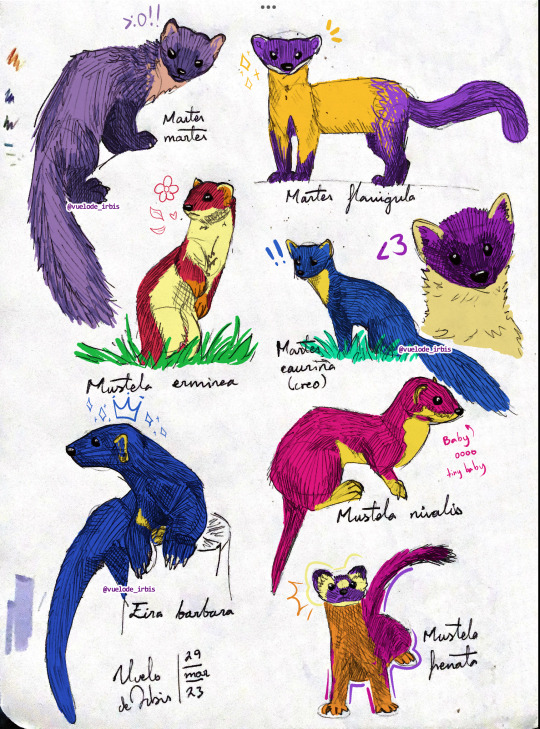
Mustelids I drew traditionally and colored digitally <3
references from pinterest
ID: a scanned photo of a page with mustelids drawn traditionally with a pen, and colored digitally with saturated colors. Each individual has their scientific name written below. From left to right and downwards, there are european pine marten (Martes martes), in purple and peach pink; yellow-throated marten (Martes flavigula) in yellow and purple; ermine (Mustela erminea) in pinkish red and cream; pacific marten (Martes caurina) in blue and yellow, and a portrait of the same species in purple and cream; tayra (Eira barbara) in blue and yellow; weasel (Mustela nivalis) in pink and yellow, and long-tailed weasel (Mustela frenata) in dark pink, orange, purple and cream. End ID.
#irbis draws#been obsessed with mustelids lately i hope i draw more of them#animal art#mustelids#mustelidae#marten#pine marten#yellow throated marten#ermine#stoat#weasel#tayra#long tailed weasel#tradtional art#sketchbook
93 notes
·
View notes
Text

Jet and his boygirlfriend,
Artwork and characters by me
Characters: (left) Martez The Pacific Pine Marten (He/Hir) (right) Jet The Wolverine (He/Him)
7 notes
·
View notes
Text
Phylogenetic weasel tournament
Family: Mustelidae
Subfamily: Guloninae
Genus: Martes


These two martens are very similar in looks, often the only way to differentiate them is genetic analysis. The main difference is in their distribution:

American marten


Pacific marten


pictures: 1, 2, 3, 4, 5, 6, map
#polls#tournament poll#phylogenetic weasel tournament#guloninae#american marten#pacific marten#american pine marten
53 notes
·
View notes
Text
Since rainbow high is getting extremely worrisome w the new line I’ve coped by making my own wave 6 (drumroll please):
Scarlet, Pumpkin, Mustard, Moss, Cornflower, Royal Purple!
Tbh I was just listing off colors I wished we had gotten in a gc and then realized a) they made a rainbow and b) they were all autumnal themed so I made an inadvertent autumnal wave! All with two outfits bc I’m allowed to dream. I want to make them eventually too bc hello my New Year’s resolution is to make more customs than last year.
Scarlett Connell (scarlet red/orange): a multimedia artist with a passion for eco-friendly graffiti, Scarlett Connell hails from the Pacific Northwest. Growing up on the Oregon coast, Scarlett fell in love with thrifting materials from old logging camps and cargo railroads. Her main outfit is a scarlet beanie, a scarlet plaid scarf, a white tank top, a pair of patchwork scarlet overalls, and graffitied scarlet doc martens. Her second outfit is a scarlet oversized flannel, faded rainbow dream t shirt, torn/cuffed scarlet jeans, and short scarlet rain boots. She keeps her makeup subtle save for a bold detail (scarlet tinged lip, blush, natural brows, graphic scarlet eyeliner) and her scarlet hair straight and chin length. Y’all…she’s the red/orange butch doll we’ve all been waiting for.
Paloma Gordon (pumpkin orange): a sweet-as-can-be baking and pastry major from Salem, Massachusetts. Growing up in such an autumnal region made Paloma fall in love with both the flavors and fashions of the season. Her primary outfit is a pair of cropped ankle pumpkin pants, pumpkin crocs, a white chef coat w pumpkin buttons, and a pumpkin orange neckerchief. Her second outfit is a pair of pumpkin plaid woolen pants, a white cable knit sweater w pumpkin detailing, and pumpkin suede booties. Her makeup is soft and warm yet very, very precise: much like her approach in the kitchen, and she keeps her hair in long curly pumpkin orange ringlets, tied back in a high ponytail. I always wished rh would do a baking major since culinary arts are some of the most impressive art forms in the world (we almost got there w poppy).
Amelie “Frenchie” du Mous (mustard yellow): always on point, Frenchie hones all of her high fashion skills from growing up in Paris into a neatly tailored fashion focus. Her primary outfit is a plaid mustard pinafore over a lace trimmed white blouse with bell sleeves, mustard yellow knee high socks, brown heeled oxfords with mustard laces, and a mustard beret trimmed in white lace. Her second outfit is a pair of knee length mustard plaid shorts w matching suspenders, platform mustard leather loafers, mustard mid calf socks, and a white puffed short sleeved blouse with a mustard plaid bow tie. Her hair is straight and long in two tails. We never got a dark academia girl so here she is to fall in love w scarlet
Ivy Pines (moss green): emerging from the woods for the first time in her life, Ivy is ready to bring her foraging gift to Rainbow High! Her art has always been from the forest around her and her family in Northern California, whether she’s crafting her own dyes or whittling intricate jewelry. Her first outfit is an ombré dip-dyed lace maxi dress (white into moss green) with thin straps, an oversized moss green cardigan, knit to texturally simulate moss (look up moss stitch w this specific rough spin yarn istg it looks just like moss), moss sandals, moss socks, and wooden jewelry with moss jewel accents. Her second outfit is moss green crochet pants, moss flats, and a white peasant top w moss embroidery. Her makeup is natural with mossy green eyeshadow, and her hair is loose beachy waves. She’d come w alt heeled feet but both her shoes would be flat :0. She’s the mori girl we deserved but never actually got.
Corinne St. Germaine (cornflower blue): traveling all the way from Middle-of-Nowhere, Nebraska, Rainbow High is Corinne’s first interaction outside of her hometown’s sixty people. She’s not totally ignorant of the world though—she’s actually huge on the internet! Her fashion style has been dubbed Lolita Americana: gold rush pioneer outfits through a cute girly lens. Her first outfit is a cornflower blue pioneer dress with a knee length hem, high neck collar, long slightly puffed sleeves, and white apron, as well as lace knee high cornflower stockings, cornflower leather ankle boots, and a cornflower bonnet trimmed in white lace. Her second outfit is a cornflower wool coat, long cornflower wool skirt, and knee high cornflower riding boots. Her hair would have a soft wave and probably be in a half up style, and her makeup would be soft. In a perfect world she’s also got a parasol >:3
Leanna Royale (royal purple): Known for clothing real life royals and only the most fashionable celebrities, the prestigious House Royale has unveiled its latest stride into the fashion world: a daughter named Leanna. Raised from birth on fine art and livery, Leanna is a princess in all but political power. Her first outfit is a polished royal purple velvet pantsuit with a royal satin shirt and purple velvet heeled pumps. Her second outfit is a silk bejeweled minidress, royal purple bejeweled strap heels, and a royal purple fur stole. Her makeup is elegant and refined, complete with a royal purple lip. Her hair is long royal purple locs in an elegant updo, and yes: she has a tiara. She’s every bit of posh violet wishes she could be (/hj)
I’m gonna try and make these! Bases would probably be whatever I can find that’s cheap, though a good visualization I’m going on rn is based on the color create dolls (scarlet and mustard for green eyes, pumpkin and royal for purple eyes, cornflower and moss for blue eyes). Maybe I won’t go so far to do two outfits but I’ll try and at least make one for each :)
9 notes
·
View notes
Text

Alt fursona, he is a pacific marten, I chose that specific species cause I’m from Cali (so cal not nor cal) and this is a species from Cali (nor cal but close enough) yeah! Debating whether to make my fursuit him or possibly a wolf (Mexican grey wolf) cause I like the idea of having a marten fursuit but I also relate more to canids than mustelids so a wolf would make more since (plus I have a long history of being obsessed with wolves to the point of making a wolf pack with a old friend who I’ve now lost touch to,) anyways rambling aside, here’s Martez the Pacific Marten (NOT A PINE MARTEN!!!) (sorry google is just not useful anymore for looking stuff up… shows me completely different things)
#art#anthro#furry#furry art#fursona#my art#sfw anthro#sfw furry#marten#pacific marten#furry reference sheet#furry ref sheet#mustelid#mustelid fursona
1 note
·
View note
Text
tag game twos-day
thank you to @celestialmickey for tagging me and creating fun tag games every week 🌟
name: michelle
your birthday: oct 24th
where in the world are you? somewhere in the pacific northwest, canada
when did you join tumblr? 2010 - i lost access to my first account in high school unfortunately
do you have any sideblogs? nope
mobile or desktop? mobile mostly to scroll, but sometimes i use desktop if i want to post something
your perfect sleeping conditions: warm under blankets in a cool room
a movie you think everyone should see at least once: parasite
what shoes do you wear the most often? black dr martens or blundstones
describe your keys to me: i have my apartment keys, my parent's house key, car keys, a mini swiss army knife, a bunch of keytags, a sushi cat keychain, & a blue miffy plush i got at the MoMA years ago, all on a gold metal big keyring i can slip my hand through (very extra i know)
find the book closest to you. turn to page 7. what’s the 7th word? is
what’s your favorite snack? japanese fruit jelly cups or sour cream and onion chips
one of your aspirations: write more, read more, watch more movies
and finally, tell me a random fact about yourself: i can speak cantonese and mandarin
& this picrew - i call it, ✨ ethereal spring chicken ✨

i'll tag @gardenerian @thisdivorce @spoonfulstar @gallawitchxx @callivich @juliakayyy @lingy910y @palepinkgoat @suzy-queued @deedala @sam-loves-seb @sickness-health-all-that-shit @crossmydna @francesrose3 @whatthebodygraspsnot @ardent-fox @too-schoolforcool @heymrspatel @stocious @squidyyy23 🖤
17 notes
·
View notes
Text
Cashier: your total is 37.55$
Pacific Northwesterner with fake doc martens, space print lulu lemons and poly face: feels terfy and exclusionist.
5 notes
·
View notes